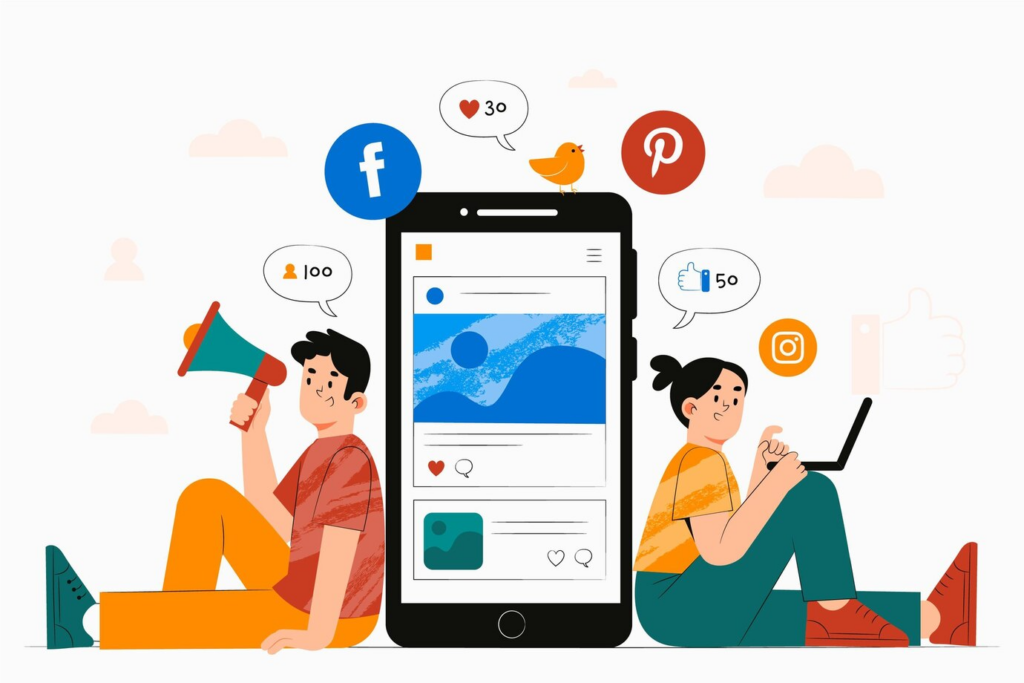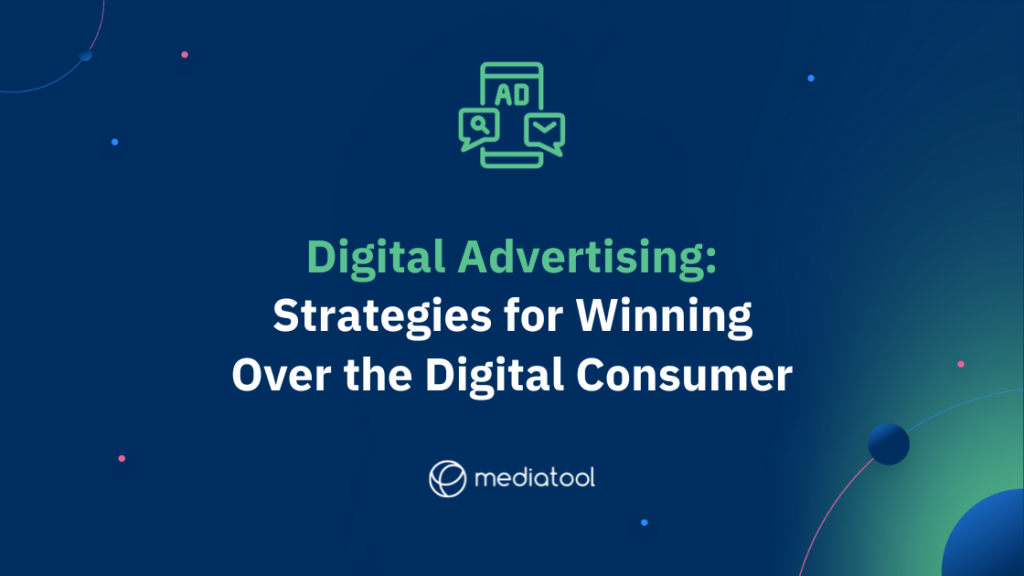Do the continuous waves of digital ads across your screen leave you feeling overwhelmed? In this digital marketing era, escaping online advertising seems nearly impossible. Be it social media ads on various platforms, video ads interrupting your stream, or banner ads lining your search results—it’s the omnipresent challenge of our time. Yet, what you might perceive as an annoyance is actually a sophisticated digital advertising strategy in play. Every search ad on search engines, each social media advertising attempt on your feed, and all forms of display advertising are part of a meticulously crafted digital ad campaign.
In this exploration, we’ll demonstrate how search engine marketing and social media ads are tailored to the target audience through various formats, from traditional advertising to innovative digital ad formats. We’ll provide digital advertising examples that break through the noise, discuss how businesses partner with search engines like Google to maximize ad spending, and detail how native ads can enhance rather than disrupt the user experience.
We’ll also compare the effectiveness of digital channels against traditional ads, analyze the roles of video streaming platforms and social media in shaping ad campaigns, and reveal how digital advertising metrics guide a campaign’s performance.
Let’s get into how digital advertising refers to more than just sales—it’s about crafting a narrative and making genuine connections, positioning it not only as the future of advertising but its very heartbeat today.

What is Digital Advertising?
Ever found yourself explaining to your grandma what Wi-Fi is? Well, explaining digital advertising is a tad easier, but let’s dive deep.
Digital advertising promotes products, services, or ideas through online channels. It’s more than just placing ads; it involves strategic planning and the use of technology to maximize the potential of these promotions.
The scope of digital advertising is vast, overcoming the limitations that traditional advertising faces, such as fixed space and limited reach. Instead of just sending out messages, digital advertising focuses on engaging with the target audience directly.
This area is ever-changing. Ad campaigns can be adjusted quickly based on how the audience responds, ensuring that the approach can be improved continuously for better results.
Analytics play a crucial role here. Every online interaction provides valuable data that helps advertisers understand consumer behavior and preferences. This data is then used to tailor strategies for greater engagement, aiming to create interactions that are meaningful and relevant to the user.
Digital ads are used across various platforms, such as search engines, social media, and other websites. They come in different formats, including text, video, and image ads, and are designed to engage the audience where they are most active online. The strategies are crafted to use the advertising budget efficiently and include measuring campaign performance with advanced metrics.
Companies collaborate with online channels to place these ads, striving to provide content that captures the interest of the target audience amidst the challenges of ad blockers and the vast amount of content online. The goal is to stand out and be seen as relevant and engaging by those who come across the ads.
Why is Digital Advertising Important?
Let’s play a quick game. How often do you check your phone daily? Weekly screen time? Have you ever clicked on an ad because it was just what you thought about? If you’re nodding along, you’ve just scratched the surface of why digital advertising is essential in today’s age.
This year, a whopping $626.86 billion is expected to flow into digital advertising, showing how much the industry is growing. In the busy world of the internet, brands that use digital ads to their advantage by reaching the right people at the right time are the ones that will succeed.
Location, Location, Location
Remember the old business mantra? In the digital realm, everyone’s online. From your tech-savvy niece to your grandpa sharing (or over-sharing) family pics, the virtual world is a bustling metropolis, 24/7. So, if you’re a brand, where better to set up shop? Digital advertising ensures businesses aren’t just part of the conversation; they’re sparking it.
The Power of Real-Time Engagement
Let’s contrast, shall we? Traditional advertising: You place an ad, cross your fingers, and maybe, three months later, get some vague metrics. Digital advertising? You launch a campaign in the morning and have insights by lunchtime! How many clicked? Who made a purchase? Did they laugh at that punny joke? Instant feedback means instant improvements.
Cost-Effective & Efficient
Let’s be real. Not everyone’s got the budget of a global conglomerate. For small businesses, especially, every dollar counts. Digital advertising provides a bang for your buck — with the ability to target specific demographics, interests, and behaviors.
Evolution is the Name of the Game
Trends change, and oh boy, do they change fast online. Remember that dance craze from last month? Or was it last week? Digital advertising allows brands to stay in tune with these shifts. It’s not just about being relevant; it’s about being a trendsetter. Brands can morph, adapt, and pivot, ensuring they’re not just keeping up but leading the pack.
Interactivity & Immersion
Gone are the days when audiences were just passive spectators. With digital advertising, they’re active participants. Whether it’s a quirky quiz, an interactive video, or a shoppable post, audiences are not just viewing content but immersed in it. This deep engagement creates stronger brand recall and loyalty.
Building Long-Term Relationships
With the power of retargeting, personalized content, and engagement analytics, brands can nurture their relationships with consumers. It’s not just about that one sale; it’s about creating brand advocates.
Digital advertising, with its diverse ad formats and strategic use of digital advertising metrics, is more than just a part of the market—it’s the driving force behind it. It’s not only changing the game; it’s creating a whole new playing field where businesses partner with online channels, using Google ads and social media advertising to connect with website visitors and mobile app users alike.
By harnessing the power of search engines, social media, and various types of digital advertising, brands can create a marketing strategy that’s not only current but also future-ready. From traditional ads to the latest in native advertising, the goal is to provide relevant content that captures and keeps attention in a world where ad blockers and competing online marketing messages are the norm.
Digital advertising turns every search result, every social media scroll, and every video ad into an opportunity for brands to meet their customers exactly where they are with content that resonates and engages.
What are the Different Types of Digital Advertising?
Digital advertising is a broad and dynamic field with many different advertisements, each serving a specific purpose and reaching a wide range of audiences. Video ads on streaming platforms are designed to be engaging and capture the viewer’s attention through compelling visuals and storytelling.
Banner ads are placed on various websites meant to attract users by integrating with the site’s content and offering visual appeal. This field provides many options and strategies, and understanding the specifics can help navigate the choices for effective advertising.
Banner and Display Ads
As you navigate through articles or scour web pages, a display ad might catch your eye—much like a billboard on a digital street—except with the added allure of interactivity. These banner ads, often seen on particular websites, are more than just static images; they beckon with animations and are integrated into your online experience without disrupting it, inviting website visitors with a click.
With the trend towards mobile usage, it’s projected that by 2026, mobile platforms will account for 70% of all digital advertising. This pivotal shift underscores the growing importance of mobile-optimized advertisements and the necessity for advertisers to prioritize the mobile experience in their campaigns.
Search Engine Ads
When you type a query into a search engine, it’s like summoning a knowledgeable friend who directs you to the perfect spot. Enter search ads, those helpful signposts that pop up in search engine results, guiding you precisely to the “best match” diner or the ideal store for those trendy sneakers you’ve been eyeing. Utilizing platforms like Google Ads, these ads reach their target audience with uncanny accuracy, often resulting in effective pay-per-click outcomes and becoming a cornerstone of any savvy digital marketing strategy.
A substantial 68% of digital journeys start with a search engine, highlighting its role as the gateway to the online world.
Social Media Advertising

Our social media feeds sometimes know us uncannily well, introducing us to products and experiences through social ads that seem tailor-made for us. The precision of social media advertising, leveraged by platforms like Facebook and Instagram, taps into a rich well of user data, crafting promotional content that not only captures attention but also encourages shares and likes, creating a viral potential.
Email Advertising
Far from obsolete, email remains a powerhouse for direct engagement. The right email ad can be a personalized invitation, bypassing ad blockers and landing directly in your inbox, carrying with it newsletters, exclusive offers, and more, all tailored to pique your interest and draw you back for repeat engagements.
Video Ads
Venture into the world of video channels, and you’ll encounter video ads that range from the succinct and snappy to the storytelling marvels that hold viewers spellbound. On platforms like YouTube, these ads offer a mix of skippable and non-skippable formats, allowing for a variety of engagement models that can leave lasting impressions. A striking 91% of companies now incorporate video content into their marketing arsenals, harnessing its potential to captivate and convert.
Native Advertising
Native ads blend into the content of a platform so seamlessly, you might not even spot them at first glance. They’re the chameleons of digital advertising, offering relevant content in the guise of genuine articles or posts, enhancing the user experience by providing value without the hard sell.
Retargeting Ads
Ever noticed how certain online ads seem to follow you after you’ve left a particular website? That’s retargeting, a strategy that reminds you of what you’ve viewed, capitalizing on initial interest and often tipping the scales with a well-timed discount or offer, aiming to convert browsers into buyers.
Affiliate Marketing
In this digital age, affiliate marketing becomes a symbiotic relationship where businesses partner with individuals or other entities to amplify their reach. Through unique affiliate links, commissions are earned, knitting together a network of promotion and revenue generation.
Each digital ad format has its niche, purpose, and designed audience, whether it’s through traditional ads, text ads, or the myriad of other ad formats available. A successful marketing strategy isn’t just about choosing the right type but weaving a tapestry that blends them into a coherent and impactful digital advertising campaign, one that optimizes digital advertising metrics and ensures a robust campaign’s performance.
What Does Digital Advertising Offer that Traditional Advertising Does Not?
Picture this: traditional advertising is that trusty old bicycle you rode around the neighborhood. It’s reliable; it gets the job done. But digital advertising? It’s like swapping out that bike for a shiny new electric scooter. Both can get you places, but one’s got that extra zing! Let’s break it down.
1. Precision Targeting:
Ever felt like a billboard was speaking directly to you? Probably not. But have you felt that way about an online ad? Ding ding! Digital advertising has this uncanny ability to zero in on a specific audience. Age, location, hobbies, past purchases, and even the TV shows you binge-watch play a role. Gone are the days of casting a wide net and hoping for the best.
2. Real-Time Analytics:
Imagine launching a campaign and waiting weeks, if not months, to know its impact. Sounds archaic, right? With digital, the moment your ad goes live, the data starts rolling in. Click-through rates, conversion rates, bounce rates – you name it. This doesn’t just satisfy our modern impatience; it’s crucial for making on-the-fly adjustments to ensure optimal performance.
3. Flexibility and Adaptability:
If a print ad has a typo, that’s a whole lot of paper (and money) down the drain. But a typo in a digital ad? A few clicks and voila, problem solved. Digital advertising is not set in stone. It can be tweaked, adjusted, or overhauled based on feedback, performance, or changing market conditions.
4. Cost-Effectiveness:
Let’s talk dollar bills! Traditional media spaces can be pricey, whether a magazine page or a primetime TV slot. Digital advertising, with its plethora of options, allows for budget flexibility. From pay-per-click, where you spend only when someone clicks on your ad, to sponsored posts that can be boosted with as little as $5, it’s a realm that welcomes the big players and the bootstrapped startups.
5. Interactive and Immersive Experiences:
Traditional ads can talk at you, but digital ads? They converse with you. Whether it’s an interactive poll on Instagram, a fun quiz that recommends products, or AR experiences that let you virtually “try on” makeup or clothes – digital advertising thrives on engagement, not just passive consumption.
6. Continuous Engagement:
While traditional ads have a limited lifespan, digital ads allow for continued engagement. From retargeting strategies that remind users of their abandoned shopping carts, to email campaigns that offer personalized recommendations – it’s a relationship that grows.
7. Global Reach:
Why limit yourself to a local newspaper ad when your potential customers could be from anywhere around the globe? Digital advertising doesn’t recognize geographical borders. A boutique in Brooklyn can attract buyers from Bali, all thanks to the power of digital channels.
8. Environmentally Friendly:
Bonus point! Digital advertising reduces the need for physical materials, making it a greener option. So not only are you reaching your target audience, but you’re also doing Mother Earth a solid.
While traditional advertising will always have its charm and certain undeniable strengths, digital advertising is like a Swiss Army knife in the world of promotions – multi-faceted, adaptable, and ready to tackle the ever-evolving challenges of the marketplace.
Steps to Building an Effective Digital Advertising Strategy

Are you starting with digital advertising? Excellent! Approach this as you would plan for any significant project. A successful endeavor in digital advertising demands more than just eagerness; it calls for a well-thought-out strategy. Here are the key elements you need to consider:
- Set Clear Objectives: Before setting out, define your goals. Clarity ensures every action aligns with your purpose, whether brand awareness, sales boost, web traffic, or customer loyalty.
- Understand Your Audience: Create detailed audience profiles. This isn’t about generalized demographics; it’s understanding specific preferences and behaviors.
- Pick Suitable Platforms: Each platform serves a distinct audience. Select where your potential customers are most active and engage there.
- Design Standout Content: Content is king. Make sure yours is compelling, whether it’s eye-catching visuals or engaging copy.
- Allocate Budget Effectively: A great strategy requires sufficient funding. Distribute your budget based on platforms and methods offering the best potential ROI.
- Regularly Test Your Ads: Utilize A/B testing to determine which ad variants work best. Refine based on results.
- Master Analytics: Leverage tools like Google Analytics to understand performance metrics. It offers insights into what’s working and why.
- Stay Adaptable: The digital landscape is fluid. If something isn’t working, adjust your approach. Adaptability is crucial.
- Engage with Your Audience: Foster a two-way conversation. Engage with comments, feedback, and build a digital community. It strengthens customer relationships.
- Commit to Ongoing Education: Digital trends evolve rapidly. Stay updated with industry news and advancements. Remember, staying informed is staying ahead.
Creating an effective digital advertising strategy is both an art and a science. It requires creativity, data-driven decisions, persistence, and a sprinkle of audacity. And with these steps in your playbook, you’re not just geared for the game; you’re playing to win.
Conclusion
Digital advertising stands at the forefront of the modern marketing revolution, weaving together the innovative threads of technology and strategy to engage with audiences across the globe. Unlike traditional ads, digital ads offer unparalleled precision in targeting and the ability to measure campaign performance with digital advertising metrics, revolutionizing how we understand ad spend and its impact.
From social media platforms to video streaming platforms, digital channels have expanded the horizons of advertising. Social media advertising alone has changed the dynamics of engagement, allowing brands to interact with their target audience in real time, leveraging insights from search engines and online channels to fine-tune their marketing strategy. The traditional banner ad has evolved into sophisticated display ads, and the omnipresence of social media ensures that banner ads are no longer mere distractions but tailored invitations to explore and engage.
While the array of digital ad formats—from video ads to native ads, from search ad integrations on search engine results pages to interactive display advertising on web pages—can be dizzying, each serves a specific purpose within a brand’s marketing strategy, ensuring that every dollar spent is an investment towards more precise customer connections.
Search engines like Google have become the new battleground for visibility, with search engine results often dictating the success of an online marketing strategy. Google Ads and other paid search avenues offer immediate and powerful means to place brands at the top of these results, while social media advertising harnesses the data-rich environment of platforms like Facebook and Instagram to deliver personalized experiences.
In this digital age, online ads are more than just placeholders on a website; they are dynamic tools that enable immersive experiences, foster long-term customer relationships, and provide value in a cost-effective manner. The key lies in understanding and mastering the diverse ad formats, utilizing online channels effectively, and respecting the audience’s attention amidst challenges like ad blockers.
Digital advertising extends beyond the immediate sale, aiming to build brand loyalty and turn website visitors into advocates. With tools like Google Analytics, digital marketing professionals can track how much revenue each ad generates, making every part of the digital advertising process—from display ad creation to ad copy refinement—measurable and actionable.
It’s not just about the technology or the platforms; it’s about creating meaningful connections with people. By meeting the target audience where they are most engaged, through the screens of their devices, brands can create moments that resonate, inspire action, and drive the evolution of commerce in this digital era.





